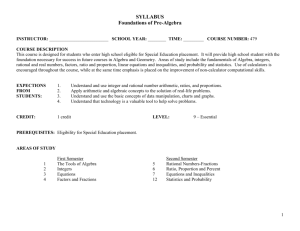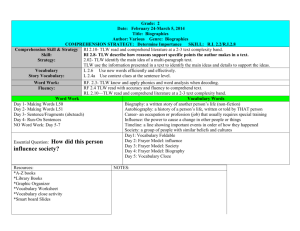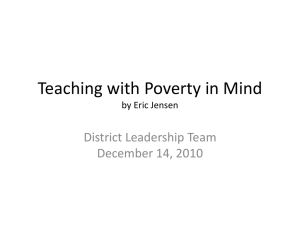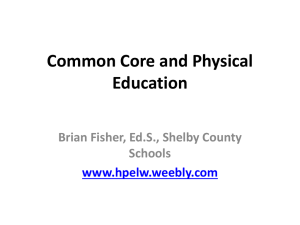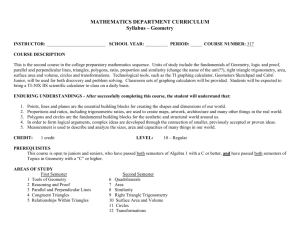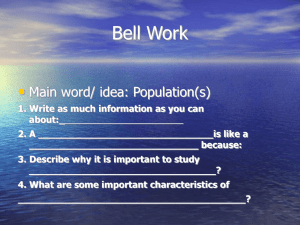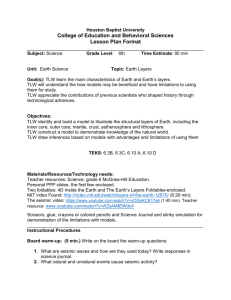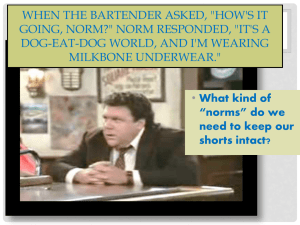Monday, October 19, 2009 Physical Science TLW describe ionic
advertisement
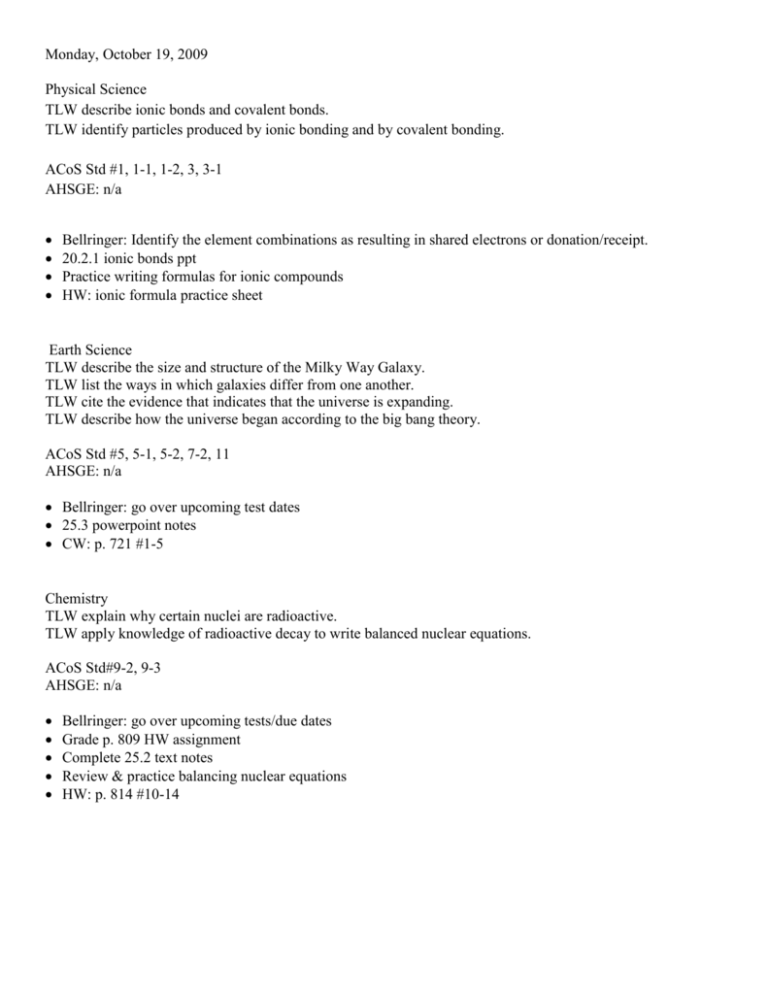
Monday, October 19, 2009 Physical Science TLW describe ionic bonds and covalent bonds. TLW identify particles produced by ionic bonding and by covalent bonding. ACoS Std #1, 1-1, 1-2, 3, 3-1 AHSGE: n/a Bellringer: Identify the element combinations as resulting in shared electrons or donation/receipt. 20.2.1 ionic bonds ppt Practice writing formulas for ionic compounds HW: ionic formula practice sheet Earth Science TLW describe the size and structure of the Milky Way Galaxy. TLW list the ways in which galaxies differ from one another. TLW cite the evidence that indicates that the universe is expanding. TLW describe how the universe began according to the big bang theory. ACoS Std #5, 5-1, 5-2, 7-2, 11 AHSGE: n/a Bellringer: go over upcoming test dates 25.3 powerpoint notes CW: p. 721 #1-5 Chemistry TLW explain why certain nuclei are radioactive. TLW apply knowledge of radioactive decay to write balanced nuclear equations. ACoS Std#9-2, 9-3 AHSGE: n/a Bellringer: go over upcoming tests/due dates Grade p. 809 HW assignment Complete 25.2 text notes Review & practice balancing nuclear equations HW: p. 814 #10-14 Tuesday, October 20, 2009 Physical Science TLW describe ionic bonds and covalent bonds. TLW identify particles produced by ionic bonding and by covalent bonding. TLW explain how to determine oxidation numbers. TLW write formulas and names for ionic compounds. ACoS Std #1, 1-1, 1-2, 3, 3-1 AHSGE: n/a Bellringer: Write formulas for the element combinations listed. 20.3 naming ionic compounds notes & practice naming ionic compounds HW: selected problems from ionic naming worksheet Earth Science TLW describe what astronomers can learn by studying star properties. TLW explain how distance affects parallax. TLW list the factors that determine a star’s apparent magnitude. TLW describe the relationship shown on a Hertzsprung-Russell diagram. TLW identify which stage marks the birth of a star. TLW explain why all stars eventually die. TLW list the stages of the sun’s life cycle. TLW describe the size and structure of the Milky Way Galaxy. TLW list the ways in which galaxies differ from one another. TLW cite the evidence that indicates that the universe is expanding. TLW describe how the universe began according to the big bang theory. ACoS Std #5, 5-1, 5-2, 7-2, 9, 9-2, 11 AHSGE: n/a Bellringer: Assign questions Ch 25 Study Guide HW: study for Ch 25 vocabulary quiz Chemistry TLW describe how induced transmutation is used to produce a transuranium element. TLW solve problems involving radioactive decay rates. ACoS Std#9, 9-2, 9-3 AHSGE: n/a Bellringer: Predict the type of decay 25.3 notes & practice solving radioactive decay rate problems HW: p. 819 Mini Lab Wednesday, October 21, 2009 Physical Science TLW explain what a chemical formula represents. ACoS Std #1-2, 3-1 AHSGE: n/a No bellringer: 5th & 6th period students report to computer lab Element Project Part II: powerpoint presentation 1st period students will be taking PLAN test Earth Science TLW describe what astronomers can learn by studying star properties. TLW explain how distance affects parallax. TLW list the factors that determine a star’s apparent magnitude. TLW describe the relationship shown on a Hertzsprung-Russell diagram. TLW identify which stage marks the birth of a star. TLW explain why all stars eventually die. TLW list the stages of the sun’s life cycle. TLW describe the size and structure of the Milky Way Galaxy. TLW list the ways in which galaxies differ from one another. TLW cite the evidence that indicates that the universe is expanding. TLW describe how the universe began according to the big bang theory. ACoS Std #5, 5-1, 5-2, 7-2, 9, 9-2, 11 AHSGE: n/a Bellringer: review Ch 25 vocabulary Ch 25 vocabulary quiz Trivia-style review for Ch 25 test Chemistry TLW list the founding scientists in the study of radioactivity and state their discoveries. TLW identify alpha, beta, and gamma radiation in terms of composition and key properties. TLW explain why certain nuclei are radioactive. TLW apply knowledge of radioactive decay to write balanced nuclear equations. TLW describe how induced transmutation is used to produce a transuranium element. TLW solve problems involving radioactive decay rates. ACoS Std#9, 9-2, 9-3 AHSGE: n/a Bellringer: Review Ch 25 Vocabulary Ch 25 Vocabulary Test Give study sheet Review topics as needed Paper Chromatography Lab Report due tomorrow Thursday, October 22, 2009 Physical Science TLW explain what a chemical formula represents. ACoS Std #1-2, 3-1 AHSGE: n/a No bellringer: 1st period students report to computer lab 1st period: Element Project Part II: powerpoint presentation 5th & 6th period students: go over HW & review ionic compound formulas & naming Earth Science TLW describe what astronomers can learn by studying star properties. TLW explain how distance affects parallax. TLW list the factors that determine a star’s apparent magnitude. TLW describe the relationship shown on a Hertzsprung-Russell diagram. TLW identify which stage marks the birth of a star. TLW explain why all stars eventually die. TLW list the stages of the sun’s life cycle. TLW describe the size and structure of the Milky Way Galaxy. TLW list the ways in which galaxies differ from one another. TLW cite the evidence that indicates that the universe is expanding. TLW describe how the universe began according to the big bang theory. ACoS Std #5, 5-1, 5-2, 7-2, 9, 9-2, 11 AHSGE: n/a Bellringer: review study guide Ch 25 test HW: Ch 23 vocabulary Chemistry TLW explain what a chemical formula represents. ACoS Std#3-1 AHSGE: n/a No bellringer; students report to computer lab Element Project Part II: powerpoint presentation Paper Chromatography Lab Report due Friday, October 23, 2009 Physical Science TLW describe ionic bonds and covalent bonds. TLW identify particles produced by ionic bonding and by covalent bonding. TLW explain how to determine oxidation numbers. TLW write formulas and names for ionic compounds. ACoS Std #1, 1-1, 1-2, 3, 3-1 AHSGE: n/a Bellringer: Identify the incorrect formulas/names Part I of Element Project Due 1st period review HW CW: practice writing formulas and naming ionic compounds HW: ionic compound practice sheet; study for ionic compound quiz Earth Science TLW list the major differences between the terrestrial and Jovian planets. TLW explain how the solar system formed. ACoS Std #5, 5-1, 5-3 AHSGE: n/a Bellringer: What are some of the major differences between the inner planets (Mercury to Mars) and the outer planets (Jupiter to dwarf planet Pluto) 23.1 powerpoint notes CW: p. 648 #1-5 Chemistry TLW list the founding scientists in the study of radioactivity and state their discoveries. TLW identify alpha, beta, and gamma radiation in terms of composition and key properties. TLW explain why certain nuclei are radioactive. TLW apply knowledge of radioactive decay to write balanced nuclear equations. TLW describe how induced transmutation is used to produce a transuranium element. TLW solve problems involving radioactive decay rates. ACoS Std#9, 9-2, 9-3 AHSGE: n/a Bellringer: review for test Part I of Element Project due (research information sheet & element advertisement) Ch 25 Test HW: Ch 5 vocabulary
